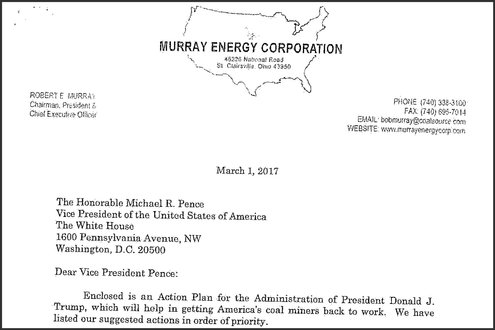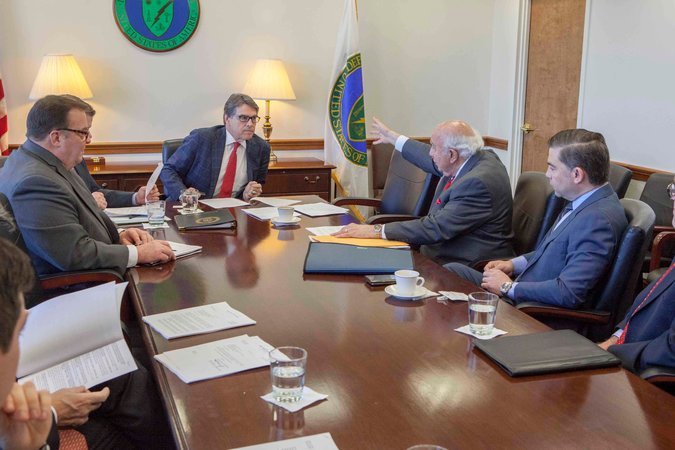“It seemed like that was the right thing to do — exercising my First Amendment rights to get the information out there,” said Mr. Edelman, who had worked at the agency since 2015 and whose job included photographing events that the agency promoted in press releases, on the web and elsewhere.
The day after the photos were published by In These Times, a liberal magazine, the Energy Department put Mr. Edelman on administrative leave, seized his personal laptop and escorted him out of its headquarters in Washington, he said. He was later told, without explanation, that his employment agreement had not been renewed, internal agency emails show.
Mr. Edelman has now filed a complaint with the Energy Department’s inspector general and, according to his lawyer, is seeking protections provided to federal whistle-blowers. On its website, the Energy Department notes that it is illegal to retaliate against whistle-blowers, who are typically protected when they alert a supervisor or the inspector general to information that they reasonably believe to constitute an abuse of authority, or other misconduct.
In the complaint, Mr. Edelman accuses the agency of retaliation and asks for his job back or at least to recover his laptop and other personal belongings. In addition, Mr. Edelman accused a former colleague of encouraging him to delete the photos of Mr. Perry and Mr. Murray, which Mr. Edelman and his lawyer argue are public records.

The Energy Department declined to discuss the circumstances surrounding Mr. Edelman’s employment, the status of the photos, or the details of his complaint, but a spokeswoman characterized his accusations as “ridiculous.” Mr. Edelman supported his complaint with emails and other documents, but some claims were based on his statements alone.
“They are based on his own subjective opinions and personal agenda,” the spokeswoman, Shaylyn Hynes, said in an email. “Industry and other stakeholders visit the Department of Energy on a daily basis. The secretary welcomes their input and feedback to strengthen the American energy sector. This meeting was no different.”
Advertisement
Continue reading the main story
A spokesman for Mr. Murray said the coal executive “does not have a recollection as to the exact statements allegedly made nearly a year ago.” The spokesman, Gary Broadbent, added that “Mr. Murray has frequently said that the Trump administration must advance reliable and low-cost electricity for all Americans and protect coal mining jobs.”
The confidential documents Mr. Murray brought to his meeting with Mr. Perry called for “rescinding anti-coal regulations of the Obama administration” and cutting the staff of the Environmental Protection Agency “in at least half,” according to portions visible in Mr. Edelman’s photographs.
Last week, The New York Times obtained a copy of a separate memo written by Mr. Murray, and reported that the Trump administration had completed or was on track to fulfill most of the 16 policy and regulatory requests contained in it. Mr. Murray told The Times the two memos essentially covered the same material.
Document
Murray Energy’s ‘Action Plan’ for the Trump Administration
Robert E. Murray’s wish list of environmental rollbacks reads like a playbook for the Trump administration.

Mr. Edelman, a Democrat, came to the Energy Department under President Barack Obama two years ago after producing videos at a consulting firm in Chicago and serving as creative director for the electoral campaign of former Gov. Pat Quinn of Illinois. After Mr. Trump’s election, Mr. Edelman said, he received greater responsibility, including photographing Mr. Perry’s meetings.
Mr. Edelman’s complaint offers a behind-the-scenes look at the meeting on March 29 between Mr. Perry and Mr. Murray, who have been friendly for many years. In addition to his company contributing $300,000 to the president’s inauguration — and personally holding a fund-raiser for Mr. Trump during the campaign — Mr. Murray has been a financial backer of Mr. Perry, a former governor of Texas who has also run for president.
In a statement, Mr. Murray’s spokesman said the company had supported Republicans “who have been staunch defenders of the United States coal industry, and the jobs and family livelihoods that depend on it, and low-cost, reliable, fuel secure electricity for all Americans.”
The meeting started, the complaint said, with Mr. Perry giving Mr. Murray “a deep bear hug.” Once they got down to business, Mr. Murray presented the memo. “This needs to be done,” the complaint says Mr. Murray insisted.
Mr. Perry replied, “I think we can help you with this,” according to the complaint.
Rattled by the exchange, Mr. Edelman said he stayed for about 15 minutes to keep listening, until he drew the attention of an agency official. “How much does a photographer need of us just sitting around?” the complaint quotes the agency official as asking.
The photos sat for months without much attention.
Then, in September, Mr. Perry proposed that the Federal Energy Regulatory Commission adopt a rule that would increase financial returns for power plants capable of stockpiling at least 90 days’ worth of fuel on-site — a plan that would effectively subsidize struggling coal and nuclear power plants, particularly in areas where Mr. Murray operates.
Advertisement
Continue reading the main story
Without the change, Mr. Perry warned, the plants could shut down, which would threaten the “reliability and resiliency of our nation’s grid.”
That phrase rang a bell with Mr. Edelman. The cover page of Mr. Murray’s memo described a plan “to assist in the survival of our country’s coal industry, which is essential to power grid reliability.”
Mr. Edelman said he decided to share the photos with the news media — The Washington Post published the images after In These Times — hoping to derail Mr. Perry’s proposed rule. The rule faced opposition from a cross section of environmental groups, energy companies, free-market advocates and former regulators, and last week, the energy commission rejected it.
Mr. Murray has said that the meeting with Mr. Perry was primarily about the need to study the resilience of the power grid, not to ask for specific actions by the energy commission or other arms of the federal government. Mr. Broadbent, his spokesman, said that “a word-for-word comparison” of the proposed rule and Mr. Murray’s action plan “reveals that they have only two words in common.”

On Dec. 7, the day after In These Times posted the photographs, and a day before they appeared online at The Washington Post, Mr. Edelman said he was summoned by his boss and told he was being placed on administrative leave with pay.
The agency later declined to extend his two-year employment agreement, which ended late last year, effectively dismissing him despite previously agreeing to extend him for two more years, Mr. Edelman said.
A security officer for the agency also refused to allow him to pack up certain personal belongings, Mr. Edelman said, including his laptop and camera equipment. The next day, a supervisor instructed Mr. Edelman in an email to provide the agency the administrative rights to the Google Drive folder where he stored the photos, according to a copy of the email reviewed by The Times.
Advertisement
Continue reading the main story
Separately, another colleague warned him over the phone that “we can come to your home and have someone watch you delete it,” Mr. Edelman said. Mr. Edelman did not record the call.
In a phone call a few days later, which was recorded, the colleague reiterated that Mr. Edelman needed to transfer ownership of the folder. “I would suggest that doing it sooner rather than later would probably be a good thing for you,” the colleague said, according to the recording, which was heard by The Times.

“You can get access to a computer,” the colleague added, “even if you need to go to a freaking library to do it.”
Mr. Edelman said the department had still not returned his laptop. Among the other items he said he left behind because of the hurried exit: a cake from his colleagues celebrating his 35th birthday.
Mr. Edelman hired a lawyer, John Tye, a former whistle-blower from the State Department who works at Whistleblower Aid, a nonprofit firm. Mr. Tye defended Mr. Edelman’s decision to keep the photos, arguing that they were “in the public domain” and were not classified, and that they had been stored on Mr. Edelman’s private drive at the Energy Department’s instruction.
By filing his complaint with the inspector general, Mr. Tye said, Mr. Edelman was seeking protections provided to federal whistle-blowers, including prohibition from “adverse employment actions and dismissal.”
After Senator Sheldon Whitehouse, Democrat of Rhode Island, heard about the incident, his office contacted Mr. Edelman, who also shared the complaint with Senator Bernie Sanders, independent of Vermont, who is a neighbor in Washington. It was Mr. Whitehouse who shared the separate memo by Murray Energy with The Times.
“Federal employees should not be fired for doing their jobs,” Mr. Sanders said in a statement. “The Department of Energy must investigate as to why Mr. Edelman was fired.”
Continue reading the main story
Article source: https://www.nytimes.com/2018/01/17/business/rick-perry-energy-photographer.html?partner=rss&emc=rss
Speak Your Mind
You must be logged in to post a comment.